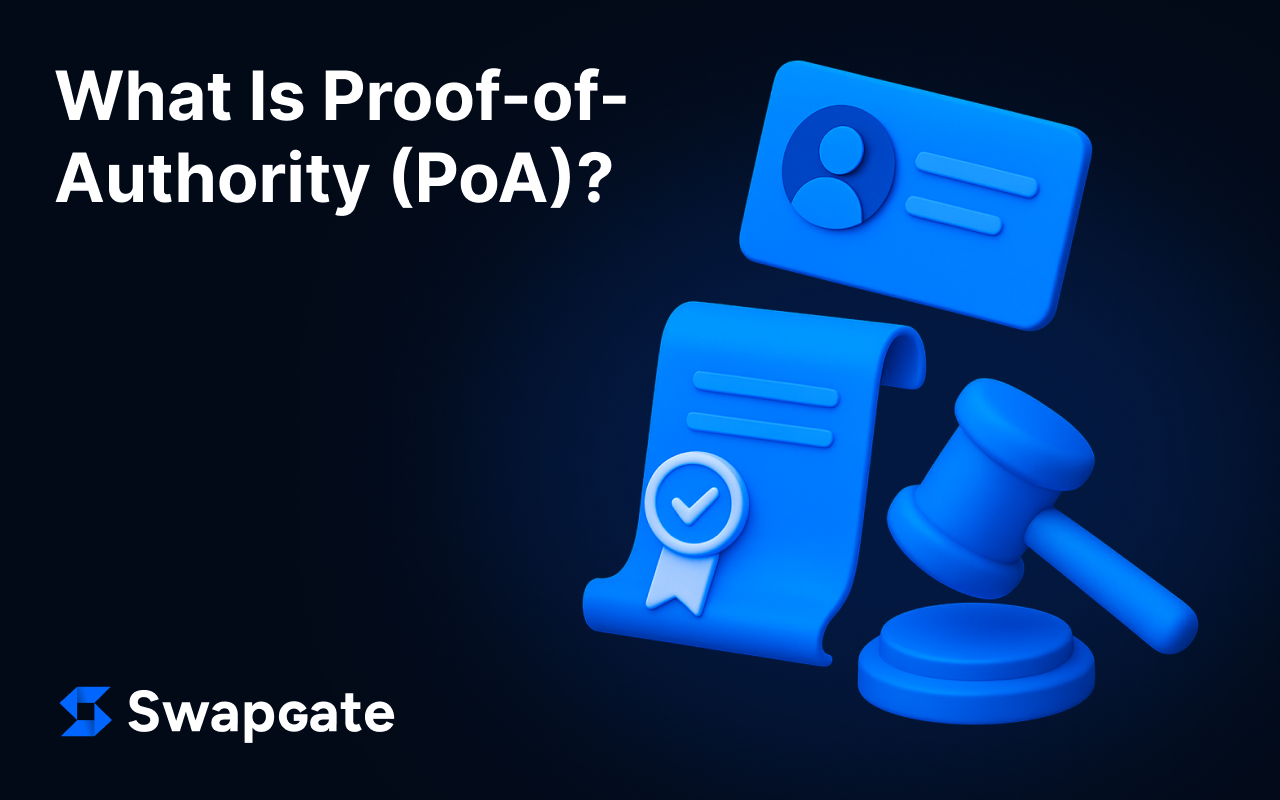
Most people encounter blockchains through Bitcoin’s energy‑hungry proof‑of‑work (PoW) or Ethereum’s stake‑based proof‑of‑stake (PoS). Yet a third consensus model—proof of authority (PoA)—powers everything from Visa’s internal settlement pilots to the European Union’s EBSI identity network. If you’ve wondered what a PoA is? or how does proof of authority work? This in‑depth guide breaks down the jargon, the governance trade‑offs and the real‑world use cases.
PoA Meaning in One Sentence
Proof‑of‑authority is a blockchain consensus mechanism where a limited set of pre‑approved validators secure the network with their public reputation—rather than computational power (PoW) or financial stake (PoS).
So, what does PoA mean? A handful of known, vetted entities take turns creating blocks, and they risk losing credibility—not coins—if they cheat.
How Does Proof of Authority Work?
- Validator vetting – An on‑chain governance contract or an off‑chain committee whitelists institutions (banks, universities, government agencies).
- Block rotation – Validators are assigned time slots in a round‑robin schedule.
- Block proposal & signature – At its slot, a validator packages pending transactions, seals the block with its private key and broadcasts it.
- Validation by peers – Other authorities confirm the signature’s authenticity and append the block to their ledgers.
- Slashing alternative – If a validator double‑signs or censors, governance can revoke its authority key.
Because each block is signed by a known entity, block time drops to seconds and energy use is negligible—ideal for high‑throughput corporate or government use.
What Types of PoA Are There?
| Variant | Key Feature | Example Network |
| Clique (Ethereum) | Tolerates temporary forks; ⅔ majority finality | Gnosis Chain pre‑Merge |
| Aura (Parity) | Fixed round‑robin slots; immediate finality | POA Network |
| IBFT 2.0 (Quorum) | Byzantine fault tolerance; supports dynamic validator sets | ConsenSys Quorum in JPM Coin |
| HoneyBadgerBFT | Asynchronous, censorship‑resistant | Cosmos Enterprise pilots |
Governance: What Can a PoA Do and Not Do?
What Can a PoA Do?
- Process 1,000+ TPS—Visa’s 2018 pilot on Hyperledger Fabric clocked 1,700 transactions per second under PoA.
- Enforce compliance—Validators can reject sanctioned addresses, aligning with AML rules.
- Schedule deterministic costs—Fixed block times make gas pricing predictable.
- Handle private data—Quorum’s privacy manager lets sub‑groups create encrypted transactions visible only to selected validators.
What Can a PoA NOT Do?
- Offer censorship‑proof guarantees like Bitcoin. A cartel of 15 banks can collude more easily than 1 million miners.
- Prevent governance capture. If the entity controlling validator admission is compromised, so is consensus.
- Deliver trustlessness. Users must trust validator identities and oversight bodies.
PoA in the Wild: Real‑World Use Cases
- Supply‑Chain Tracking (VeChain) – Luxury brands issue NFT “digital twins” of handbags; PoA’s low fees keep per‑item costs under US $0.01.
- CBDC Prototypes (Banque de France) – The bank tested wholesale CBDCs on a permissioned PoA version of Ethereum. Check this article out: CBDC vs cryptocurrency.
- Energy Trading (Powerledger) – Houses sell solar surplus on a PoA sidechain, clearing micro‑payments every 5 seconds.
- NFT Ticketing (Socio.com) – Sports clubs mint tokens on Chiliz, a PoA network with high TPS and zero MEV risk.
- EU Blockchain Services Infrastructure (EBSI) – 30 European nodes issue verifiable diplomas; PoA suits sovereign compliance.
These examples show crypto proof of authority isn’t hypothetical; it’s embedded in multi‑billion‑dollar sectors.
Security and Criticism
| Concern | Mitigation Strategy |
| Centralised attack surface | Add diverse validators—universities + auditors, not just banks |
| Sybil via stolen keys | Hardware security modules & multi‑sig keys |
| Regulatory overreach | Transparent governance charters, on‑chain voting records |
| Lack of economic penalty | Hybrid PoA/PoS chains (e.g., Binance Smart Chain initial model) |
Critics argue PoA is “just a slow database.” Proponents reply that blockchain signatures, immutability and cross‑border programmability still beat legacy systems.
Comparing PoA with PoW and PoS
| Feature | Proof‑of‑Work | Proof‑of‑Stake | Proof‑of‑Authority |
| Security anchor | Electricity + hardware | Capital at stake | Legal identity & reputation |
| Decentralisation | High (open) | Medium (wealth‑based) | Low‑medium (permissioned) |
| Energy use | High | Low | Tiny |
| Finality time | 10–60 min | Seconds‑minutes | Seconds |
| Ideal for | Public money | Public + semi‑private apps | Consortium chains, compliance‑centric |
PoA in Hybrid and Layer‑2 Architectures
- Polygon Supernets allow enterprise chains to run PoA while settling proofs on the Polygon PoS root chain.
- Arbitrum Orbit lets gaming studios spin up PoA “Layer‑3” roll‑ups, posting compressed data to Arbitrum One.
- Cosmos Zones like Persistence start as PoA until token distributions decentralise into full PoS.
Such designs blend PoA’s speed with L1 security—a middle path for adoption.
Legal and Regulatory Factors
Because validators are known, PoA networks dovetail with KYC, GDPR, and data residency laws. The SEC’s 2023 “Framework for DLT Consortia” even cites PoA as “acceptable for Restricted Securities Tokens within controlled districts.” However, antitrust and data‑monopoly rules may apply if too few entities run all nodes.
Future Outlook
IDC predicts consortium blockchains will power US $9 trillion in trade finance flows by 2030, many likely PoA‑based. Ethereum’s upcoming “Verkle trees” make light clients easier, encouraging PoA sub‑nets to anchor into public main‑nets for extra auditability.
Key Takeaways
- PoA meaning: block creation by vetted, reputationally staked entities.
- Trade‑off: speed and compliance vs. decentralisation.
- What is a PoA? A permissioned blockchain engine for governments, banks and supply chains.
- PoA crypto lives in VeChain, Chiliz, Powerledger and dozens of CBDC pilots.
- Understanding proof of authority blockchain prepares you for the next wave of regulated digital assets.
So, why would a business choose it over Bitcoin or Ethereum? PoA isn’t a one‑size‑fits-all solution, but in the right context—high compliance, low latency, identifiable stakeholders—it’s the consensus mechanism that quietly gets the job done.